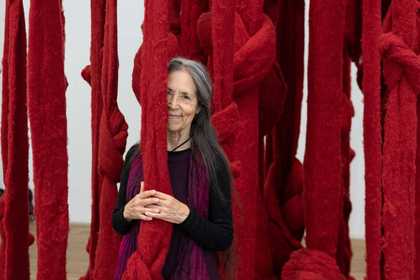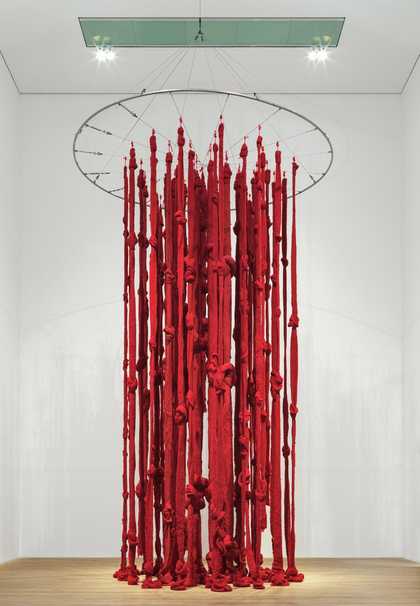You will need
- A ball of wool per group of 4–5 students
- Strips of paper
- Pens
- Tape


You will need

Cecilia Vicuña
Quipu Womb (The Story of the Red Thread, Athens) (2017)
Tate
Your students don’t need to know anything about an artwork or artist to start exploring it.
Use these quick group activities to build their confidence and curiosity in sharing their first responses to the artwork. Some artworks they might like straight away, some they might not.
Discovering art can be new, exciting and sometimes confusing. There are no right or wrong ways to respond!
In pairs or as a group, take it in turns to imagine the artworks answering these questions and telling their story.
In pairs or as a group, use your body to respond to the artwork.
"We have to reconnect and rebuild and grow... we have to work together"
Cecilia Vicuña
Quipu Womb (The Story of the Red Thread, Athens) 2017 is a sculpture made from 52 red woollen strands suspended from the ceiling. The strands are all of different lengths, with many reaching up to 12 metres! Each strand is knotted at several points across its length, becoming the metaphorical quipu in the artwork’s title.
The quipu (or khipu) is an Indigenous language recording device developed by ancient societies in the central Andes mountains and used extensively by the Inca Empire. Events, information, data and stories are collected within their knots, becoming a detailed record of everyday life. After the Spanish colonisation of South America in the 16th century, quipus were largely replaced by European writing systems, however many communities have revived them and still use quipus to this day!
Artist Cecilia Vicuña explores and transforms quipus in her artwork, which is informed by her research into Indigenous technologies. Vicuña sees her work as a ‘poem in space’, exploring the flows and cycles of nature, as well as feminist and environmental activism.
Adapt
Tie pre-made or bought cardboard tags to a length of wool that everyone can write or make marks on.
Pass the wool around the group, spending time exploring the tactile qualities of the materials, the movement and the sensation of being connected to one another.
You could also hang up the wool and tags to allow everyone to move through or under them, either individually or as a group.
Take a moment to hold onto this multi-threaded loop that connects you all together.
3. Add one of your questions to this circle of wool by folding the top of each strip of paper over one of the threads. Hold it in place with a piece of tape.
4. When everyone is ready, slowly pass the circle of wool to your right until each of you has somebody else's question in front of you.
5. Read the question to yourself. Think about it. Look again at Vicuña's artwork.
6. Answer the question from your perspective on the reverse of the paper.
Remember that there are no right or wrong answers; you are starting to form your own ideas and opinions.
7. Once everyone is finished, repeat actions 3–6 until all the questions are added and answered.
8. Spend some time handling the thread, reading out the answers and discussing everything that you have made about Quipu Womb together.
9. At the end of your lesson, find each other’s different ways of communicating and celebrate the artwork you’ve just made!
What have you learned by experimenting with language, collaboration and communication?
What do the questions you included represent to you?
Extend
Invite your students to work together and cut your circle of interlocking threads at any random point on the loop and tie with a knot at the end. Then either connect all the lengths of questions and answers in one continuous loop of ‘conversation’, or hang each of them from the ceiling in separate lengths to mirror Quipu Womb.
Once you have spent some time enjoying your display, take off all the questions and randomly distribute them around the class. Use the lines of text to create new artworks made from these words. This could be a poem or collage, or you could experiment with mixing different media together using paint, ink or pencil.
Making art is a powerful way to learn new skills, explore ideas and express ourselves creatively. Encourage your students to discover new materials, techniques and methods inspired by great artists at Tate.
1. Prepare
2. Explore (10 minutes)
3. Make (30 minutes)